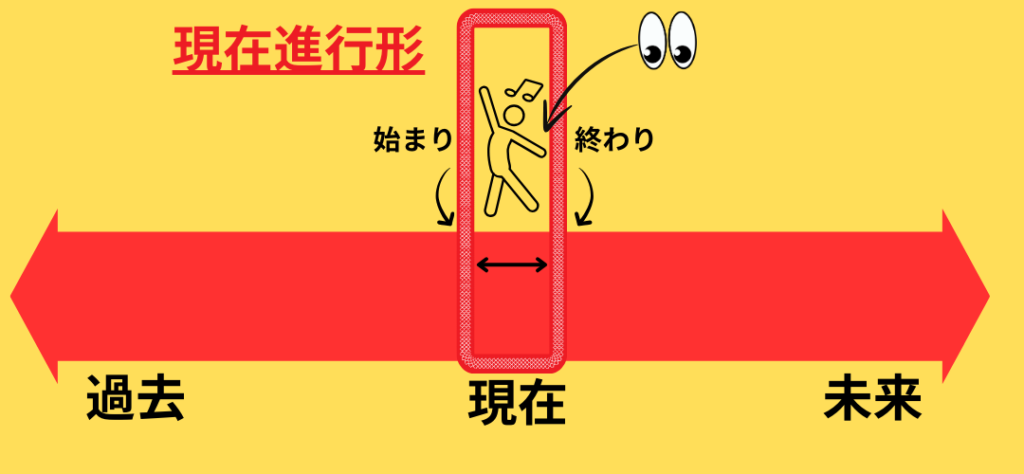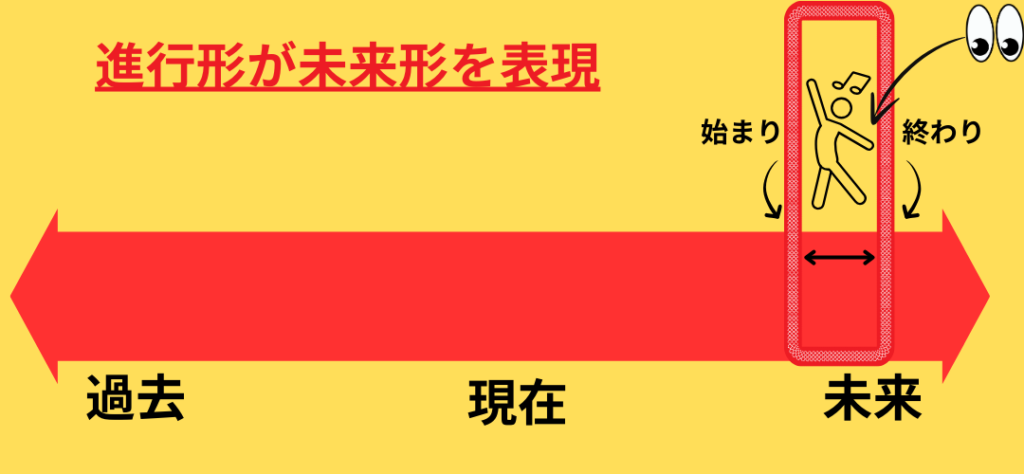英会話の中で、現在形と現在進行形が頻繁に使われます。
英語は時制がとても大切な言語です。
しかし、多くの学習者は時制を何となくしか理解できていないのが現実です。
この投稿ではイメージを使って感覚的に理解でいるように工夫しています。
ここでは、現在形と現在進行形の違いについて詳しく説明します。さらに、他の文法項目についても知りたい方は、「話すための英文法リスト」をご覧ください。

現在形と現在進行形の違い
現在形とは
まず、現在形は「現在の事」ではありません。
現在形は過去、現在、未来の事実を含みます。つまり、現在形は「いつも本当のこと」を表し、時間の枠組みに縛られません。
文法書では、一般的な事実、普遍的な真理、習慣と説明されていますが、以下のイメージで捉えると理解しやすいです。

いつも本当のことが現在形です。
例文、
- I run every day. (私は毎日走っています。)
- The sun sets in the west. (太陽は西に沈みます)
- He is nice. (彼は親切です。)
どの文も過去、現在、未来にわたって「いつも本当のこと」を表しています。
現在進行形とは
現在進行形は、特定の時間のくくりを表します。このくくりには始まりと終わりがあり、その期間内の動作や状態を表現します。以下のイメージで理解しましょう。

例えば、
- I’m having a good time. (私は楽しい時間を過ごしています。)
- I’m driving a Lexus now. (私は今レクサスを運転しています。)
- It’s taking too long. (時間がかかりすぎています。)
上の例文で使われる現在進行形の説明
- I’m having a good time: 現在、楽しい活動に参加している最中です。これが I have a good time だった場合、いつも楽しい活動に参加していることを意味します。
- I’m driving a Lexus now : 以前は違う車を運転していましたが、現在はレクサスを運転していることを表します。今後また違う車に乗る可能性も含んでいます。 I drive a Lexus だった場合、常にレクサスを運転しているニュアンスになります。
- It’s taking too long: 現在、何かが時間がかかりすぎていることに対する不満を表します。 It takes too long だと、いつも何かが時間がかかりすぎることに不満を感じていることになります。
進行形が未来形として使われる場合
現在進行形はそのまま未来形として使われることがあります。
イメージとしては、現在形のくくりが未来に移行し、未来の一定期間内の行動を表します。進行形の未来形は、willやbe going toよりも確実な未来を表します。進行形の未来形は、「私はある未来の一定期間、この行動をとっている」という断言です。

例文:
- I’m seeing my friends tomorrow at 6:00 pm for dinner.(明日の午後6時には友達に会っています。)
- She is flying to New York next week. (彼女は来週ニューヨークに飛行機で行く予定です。)
- We are having a meeting with the client on Friday. (私たちは金曜日にクライアントとの会議があります。)
- He is starting his new job next Monday. (彼は来週の月曜日に新しい仕事を始めます。)
現在形が現在進行形のクイズ
現在形か現在進行形を選ぶクイズです。現在形と現在進行形のイメージを思い出して、適切な答えを選んでください。答えは、質問の下に記載されています。
- It (rains / is raining) a lot in the winter.
- Please be quiet. (I’m working / I work) now.
- She (goes / is going) to the gym every day.
- Look! The cat (sleeps / is sleeping) on the sofa.
- We (study / are studying) English at the moment.
- He (drinks / is drinking) coffee every morning.
- They (play / are playing) soccer in the park right now.
- The store (opens / is opening) at 9 AM every day.
- I can’t talk right now. I (cook / am cooking) dinner.
- She (reads / is reading) a book in her room at the moment.
- What (do you do / are you doing) in your free time?
- Right now, we (plan / are planning) our next vacation.
- My brother (works / is working) at a bank.
- The children (make / are making) a lot of noise upstairs.
- This cake (tastes / is tasting) delicious!
- I (leave / am leaving) for Tokyo tomorrow morning.
- Why are you (nice / being nice) today? It’s not like you.
- We (watch / are watching) a movie every Friday night.
- She (practices / is practicing) the piano in the evening.
- They (move / are moving) to a new house next month.
解答
- It rains a lot in the winter.
- Please be quiet. I’m working now.
- She goes to the gym every day.
- Look! The cat is sleeping on the sofa.
- We are studying English at the moment.
- He drinks coffee every morning.
- They are playing soccer in the park right now.
- The store opens at 9 AM every day.
- I can’t talk right now. I am cooking dinner.
- She is reading a book in her room at the moment.
- What do you do in your free time.
- Right now, we are planning our next vacation.
- My brother works at a bank.
- The children are making a lot of noise upstairs.
- This cake tastes delicious!
- I am leaving for Tokyo tomorrow morning.
- Why are you being nice today?
- We watch a movie every Friday night.
- She practices the piano in the evening.
- They are moving to a new house next month.
まとめ
現在形と現在進行形の違いを理解することで、英語の時制の使い方がより明確になります。現在形は「いつも本当のこと」を表し、時間の枠組みを超えた事実を示します。一方、現在進行形は特定の時間内での動作や状態を表し、未来形としても使われることがあります。これらの違いを意識しながら、正しい時制を使って自然な英語を話せるように練習しましょう。

